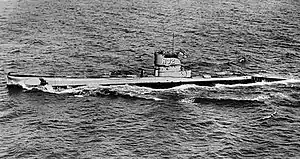HMS H32
HMS H32 was a H-class submarine constructed for the Royal Navy. The submarine entered service in 1919 and served in the Second World War, one of only seven of the class to do so. During Warship Week 1942 H32 was adopted by Lydney RDC (Gloucestershire). The submarine was sold for scrap in 1944.
 HMS H32 | |
| History | |
|---|---|
| Name | HMS H32 |
| Builder | Vickers Limited, Barrow-in-Furness |
| Laid down | 20 April 1917 |
| Launched | 19 November 1918 |
| Commissioned | 14 May 1919 |
| Fate | Sold, 18 October 1944 |
| General characteristics | |
| Class and type | H-class submarine |
| Displacement |
|
| Length | 171 ft 0 in (52.12 m) |
| Beam | 15 ft 4 in (4.67 m) |
| Propulsion |
|
| Speed |
|
| Range |
|
| Complement | 22 |
| Armament |
|
Design
Like all post-H20 H-class submarines, H32 had a displacement of 423 long tons (430 t) at the surface and 510 long tons (520 t) while submerged.[1] The submarine had a length overall of 171 feet 9 inches (52.35 m),[2] a beam of 15 feet 9 inches (4.80 m), and a draught of 13 feet 2 inches (4.01 m).[1] The submarine was driven by a two-shaft diesel engine providing a total power of 480 horsepower (360 kW) and two electric motors each providing 620 horsepower (460 kW) power.[1] The use of its electric motors made the submarine travel at 11 knots (20 km/h; 13 mph). The submarine would normally carry 16.4 long tons (16.7 t) of fuel and had a maximum capacity of 18 long tons (18 t).[3]
The submarine had a maximum surface speed of 13 knots (24 km/h; 15 mph) and a submerged speed of 10.5 knots (19.4 km/h; 12.1 mph). Post-H20 H-class submarines had ranges of 2,985 nautical miles (5,528 km; 3,435 mi) at speeds of 7.5 knots (13.9 km/h; 8.6 mph) when surfaced.[4] H32 was fitted with an anti-aircraft gun and four 21-inch (533 mm) torpedo tubes. Its torpedo tubes were fitted to the bows and the submarine was loaded with eight 21-inch torpedoes.[4] The design is based on the Holland 602 type submarine but altered to meet Royal Navy specifications. The submarine had a complement of twenty-two crew members.[4]
Construction and career
H32 was built by Vickers Limited, Barrow-in-Furness. She was laid down on 20 April 1917 and was launched on 19 November 1918.[1][5] The boat was commissioned on 14 May 1919.
Upon commissioning, HMS H32 was assigned to be a tender to the submarine depot ship HMS Maidstone. The submarine was also the first Royal Navy boat to be fitted with the ASDIC (Anti Submarine Detector Investigation Committee) underwater sensor system. At the onset of the Second World War, H32 was a member of the 6th Submarine Flotilla. From 26–29 August 1939, the flotilla deployed to its war bases at Dundee and Blyth.[6] Beginning on 22 March 1941, the Royal Navy and Allies began deploying submarines off Brest, France to prevent the German battleships Gneisenau and Scharnhorst from leaving port. H32 was among the submarines assigned to the patrol.[7]
References
- Gardiner and Gray, p.92
- Walters, p.2
- J. D. Perkins (1999). "Building History and Technical Details for Canadian CC-Boats and the Original H-CLASS". Electric Boat Company Holland Patent Submarines. Retrieved 20 August 2015.
- "H-class". Battleships-Cruisers, Cranston Fine Arts. Retrieved 20 August 2015.
- Colledge, p.280
- Rohwer, p.1
- Rohwer, p.65
Bibliography
- Colledge, J. J.; Warlow, Ben (2006) [1969]. Ships of the Royal Navy: The Complete Record of all Fighting Ships of the Royal Navy (Rev. ed.). London: Chatham Publishing. ISBN 978-1-86176-281-8.
- Hutchinson, Robert (2001). Jane's submarines : war beneath the waves from 1776 to the present day. London: HarperCollins. ISBN 9780007105588.
- Rohwer, Jürgen (2005). Chronology of the War at Sea 1939–1945: The Naval History of World War Two (Revised & Expanded ed.). Annapolis, Maryland: Naval Institute Press. ISBN 1-59114-119-2.
- Walters, Derek (2004). The History of the British 'U' Class Submarine. Casemate Publishers. ISBN 978-1-84415-131-8.